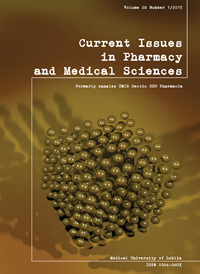The effect of one-electron reduced drugs on hepatic aconitase activity and triglycerides level
DOI:
https://doi.org/10.1515/cipms-2015-0031Keywords:
doxorubicin, thyroxin, liver, redox equilibrium, lipid metabolismAbstract
The redox cycle triggered by one electron reduction of doxorubicin and tirapazamine - both anticancer agents - leads to superoxide production. This superoxide production itself removes one iron atom from the [4Fe-4S] cluster, being an active center of aconitase. In addition, the incurred changes in cell redox equilibrium may affect lipid metabolism. The aim of the study was to evaluate a concomitant effect of both drugs on hepatic aconitase activity and triglycerides level. In our study, doxorubicin (1.8 mg/kg b.w.) was administered intraperitoneal (i.p.) six times, once a week, within male Wistar rats, to achieve a cumulative dose of 10.8 mg/kg b.w. Two hours before every doxorubicin administration, tirapazamine in the dose of either 5 or 10 mg/kg b.w. was also i.p. injected. A week after withdrawing drug administration, the liver was taken for biochemical analysis. Therein, an increase in aconitase activity and a decrease in triglycerides level was seen in all groups exposed to doxorubicin. Our work demonstrated that tirapazamine administration had no influence on both tested parameters, but its higher dose rate normalized aconitase activity affected by doxorubicin.
References
1. Abdel-aleem S. et al.: Acute and chronic effects of adriamycin on fatty acid oxidation in isolated cardiac myocytes. J. Mol. Cell Cardiol., 29, 789, 1997.
2. Bachur N.R., Gordon S.L., Gee M.V.: A general mechanism for microsomal activation of quinone anticancer agents to free radicals.Cancer Res., 38, 1745, 1978.
3. Bizzi A. et al.: Adriamycin causes hyperlipemia as a consequence of nephrotoxicity. Toxicol. Lett., 18, 291, 1983.
4. Brown J.M.: The hypoxic cell: a target for selective cancer therapy- eighteenth Bruce F. Cain Memorial Award lecture. Cancer Res., 59, 5863, 1999.
5. Czuba B. et al.: The effect of thyroxin on hepatic redox equilibrium and lipid metabolism in rats treated with doxorubicin. Curr Issues Pharm Med Sci., 27(4), 220, 2014.
6. Dorie M.J., Brown J.M.: Modification of the antitumor activity of chemotherapeutic drugs by the hypoxic cytotoxic agent tirapazamine. Cancer Chemotherapy and Pharmacology., 39, 361, 1997.
7. Dudka J. et al.: Activity of NADPH-cytochrome P-450 reductase of the human heart, liver and lungs in the presence of (-)-epigallocatechin gallate, quercetin and resveratrol: an in vitro study. Basic Clin. Pharmacol. Toxicol., 97, 74, 2005.
8. Hausladen A., Fridovich I.: Superoxide and peroxynitrite inactivate aconitases, but nitric oxide does not. J. Biol. Chem., 269, 29405, 1994.
9. Hong B. et al.: Hypoxia-targeting by tirapazamine (TPZ) induces preferential growth inhibition of nasopharyngeal carcinoma cells with Chk1/2 activation. Investigational New Drugs., 29, 401, 2011. [Web of Science]
10. Jounaidi Y. and Waxman D.J.: Combination of the bioreductive drug tirapazamine with the chemotherapeutic pro-drug cyclophosphamide for P450/P450-reductase-based cancer gene therapy. Cancer Res., 60, 3761, 2000.
11. Marcu L., Olver I.: Tirapazamine: from bench to clinical trials. Current Clin. Pharmacol., 1, 71, 2006.
12. Minotti G. et al.: Anticancer anthracyclines and the control of iron metabolism: quinine-dependent and independent mechanisms. Methods Enzymol., 378, 340, 2004.
13. Reddy S.B., Williamson S.K.: Tirapazamine: a novel agent targeting hypoxic tumor cells. Expert Opinion on Investigational Drugs., 18, 77, 2009. [Web of Science]
14. Salvatorelli E. et al.: Defective one or two electron reduction of the anticancer anthracycline epirubicin in human heart. Relative importance of vesicular sequestration and impaired efficiency of electron addition. J. Biol. Chem., 281, 10990, 2006.
15. Salvatorelli E. et al.: Pharmacokinetic Characterization of Amrubicin Cardiac Safety in an Ex Vivo Human Myocardial Strip Model. II. Amrubicin Shows Metabolic Advantages over Doxorubicin and Epirubicin. JPET., 341, 2474, 2012.
16. von Pawel J. et al.: Tirapazamine plus cisplatin versus cisplatin in advanced non-small-cell lung cancer: a report of the international CATAPULT I study group. Cisplatin and tirapazamine in subjects with advanced previously untreated non-small-cell lung tumors. J. Clin. Oncol., 18, 1351, 2000.
17. Warren K.E. et al.: Effect of fluconazole on the pharmacokinetics of doxorubicin in nonhuman primates. Antimicrob. Agents Chemother., 44, 1100, 2000.
18. Wouters B.G. et al.: Mitochondrial dysfunction after aerobic exposure to the hypoxic cytotoxin tirapazamine. Cancer Res., 61, 145, 2001.
Downloads
Published
Issue
Section
License
Copyright (c) 2015 Authors

This work is licensed under a Creative Commons Attribution-NonCommercial-NoDerivatives 3.0 Unported License.


